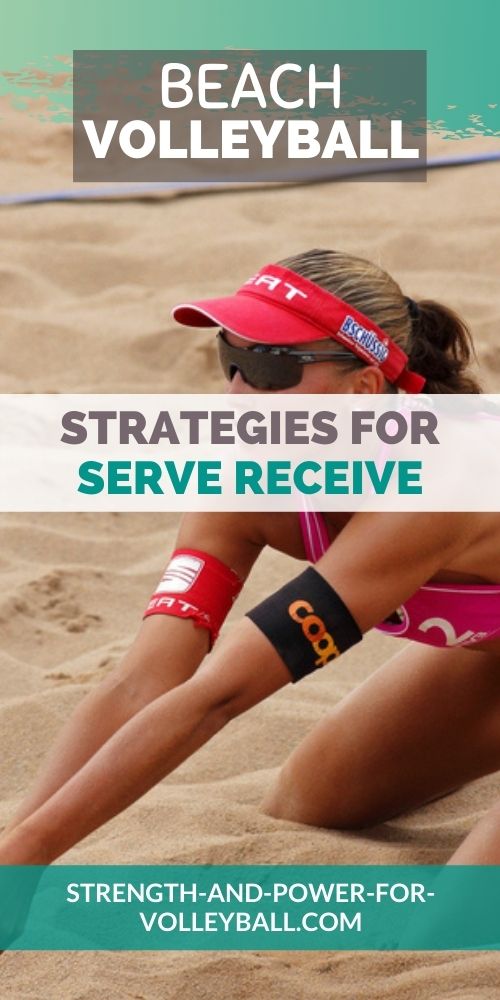Beach Volleyball Passing
Techniques and Strategies
Volleyball passing on the beach can be difficult and even seem awkward at
times. If you aren't used to moving around in the sand, it can be
difficult to get in a comfortable position to pass.
Passing on the Beach
Learning to pass is the most important skill on the beach because ball control is so important
when playing sand volleyball.
When you make a good pass, you've given your partner an easy ball to set. This
is very important because on the beach, it's can be very hard to move
around in the sand and prepare to set.
Also, when a hitter gets a good set on the beach, the kill percentage is
much higher than indoor because there are fewer player's to stop your
attack. For example,
when you hit in doubles, you likely have one blocker up at the net, and
one defender back playing defense.
Rallies tend to be much shorter on the beach when player's get a good
set to
spike.
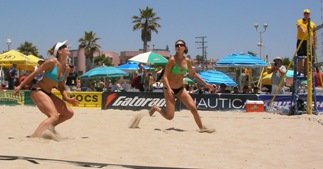
Getting in Position to Pass
A lot of times partners are small and they don't want to block. So there are situations when you'll play teams that don't block at all. It's real important to get a good set when there's no block up because with no one blocking, it will make it much easier to put the ball away for a kill.
Beach Passing Techniques
If you're new to the beach, consider the following volleyball tips for playing defense on the beach.
You'll likely noticed that many beach volleyball veterans have unusual
volleyball passing techniques.
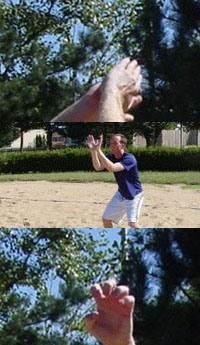
Tomahawk, Face Dig, and Knuckle Pass
example, you might have seen a beach player play a ball overhead with palms together. This is called a tomahawk. The
tomahawk is a volleyball passing method for a ball that would typically be out of reach over your head.
Since open-hand attacking with your fingers is illegal in doubles, beach players develop techniques for
playing the ball with their
knuckles to poke the ball. One handed volleyball passing techniques
can important because you often find yourself in positions where you
need to reach tight to the net and play the ball in a way to just keep
it in play.
The face dig technique is also popular on the beach.
The face dig can be an important skill for digging as well as protecting
your face for when you're caught having to play defense with no one
blocking at the net.
Strategies for Passing on the Beach
Passing in deep sand
You have to be prepared both physically and mentally to pass in the sand.
Volleyball passing is the skill that calls for the greatest attention because of how hard it is to get in position to volleyball pass. Also, there's a
constant mental war going on between the server and passer.
If you're up against a great server, great volleyball passing can neutralize this
situation.
Passing on the beach can be a real tough task because of such elements as deep sand, wind, and the sun.
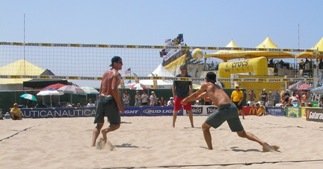
Pass then get in Position to Hit
Passing tips for playing in the sun
Many player's wear sunglasses because during the game, you look up and
if you don't have sunglasses, you likely will get blinded by the sun.
Wearing sunglasses while playing volleyball can be uncomfortable when
you
play in them for the first time, but most player's soon get used to
wearing them.
Sunglasses are also helpful for keeping sand out of your eyes. This is
especially important if you wear contacts.
Passing tips for playing in the wind
If it's windy and the wind is blowing from one end of the court to the
other, the side that's easiest to play on is the side with the wind in
your face.
This is especially true for passing. It's much easier to pass balls that
are
moving with the wind rather than against the wind.
In the wind, it's best to keep passes low because the higher the pass, the more the wind can move the ball around
which makes it more difficult to set.
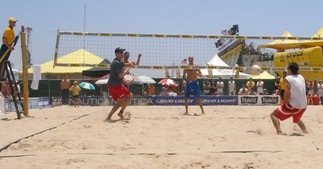
Great Passing Leads to a Great Set
Pass the ball straight ahead
On the beach, the passing target area is different than indoor sixes. In
doubles, you want to pass the ball straight in front of you. This way,
it's much easier for your partner to know where to go
to get in position to set.
Also, it's much easier to set a shorter distance (the setter is setting
more straight up and not out across the court like an indoor set).
There's only one hitter in doubles, so you aren't really trying to fool anyone with the set. This is why it's
a good strategy to pass the ball to the same side of the court as you want to hit on. It's
much easier for the setter to set on the same side of the
court, rather than having to set all the way across the court like an indoor set
to the outside hitter.
Basically, if you are on the left side, pass the ball straight ahead and
a little to the right. Most doubles player's like to be set about the
same distance
from where the ball was passed. For example, after you pass the ball,
you can expect the set to be about 3 feet out from where it's
being set from. This helps
with consistently knowing where to approach to after each time you pass.
Crosscourt player takes the middle ball
Generally, in serve receive, the crosscourt player takes the ball that's
served to the middle of the court. One reason why this is the case is
because the other player has
to prepare for the serve down the line. The serve down the line comes
much faster because the distance the ball travels is shorter. So if the
serve is
directly in front of you, hug the line a little.
Volleyball passing success on the beach calls for constant communication
between partners. The importance of good communication skills can't be
stressed enough.
Discuss before each serve who is taking the middle ball.
If you enjoyed these tips and would like to keep it close to you at any time, just save this pin to your Pinterest Volleyball Training Board.
